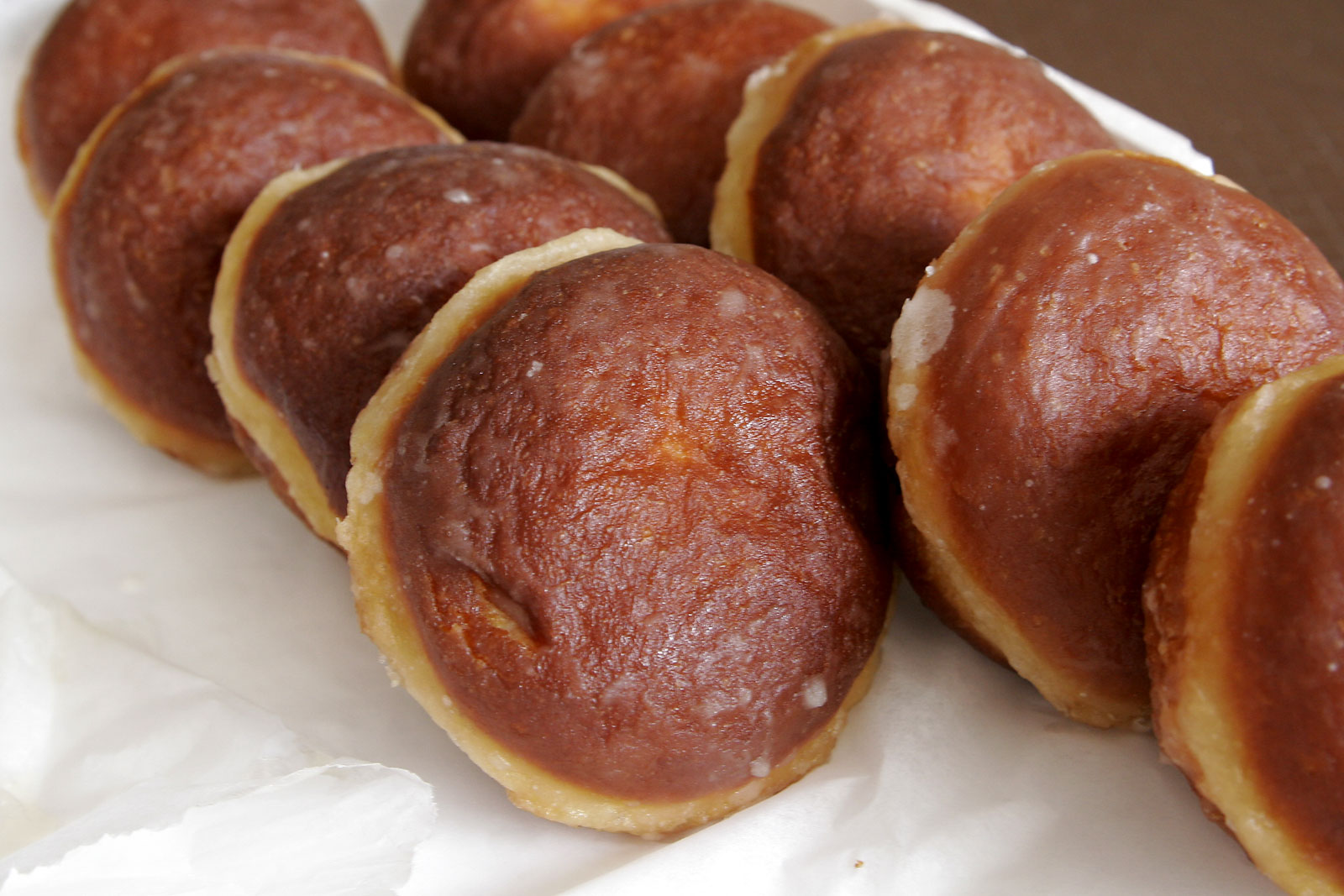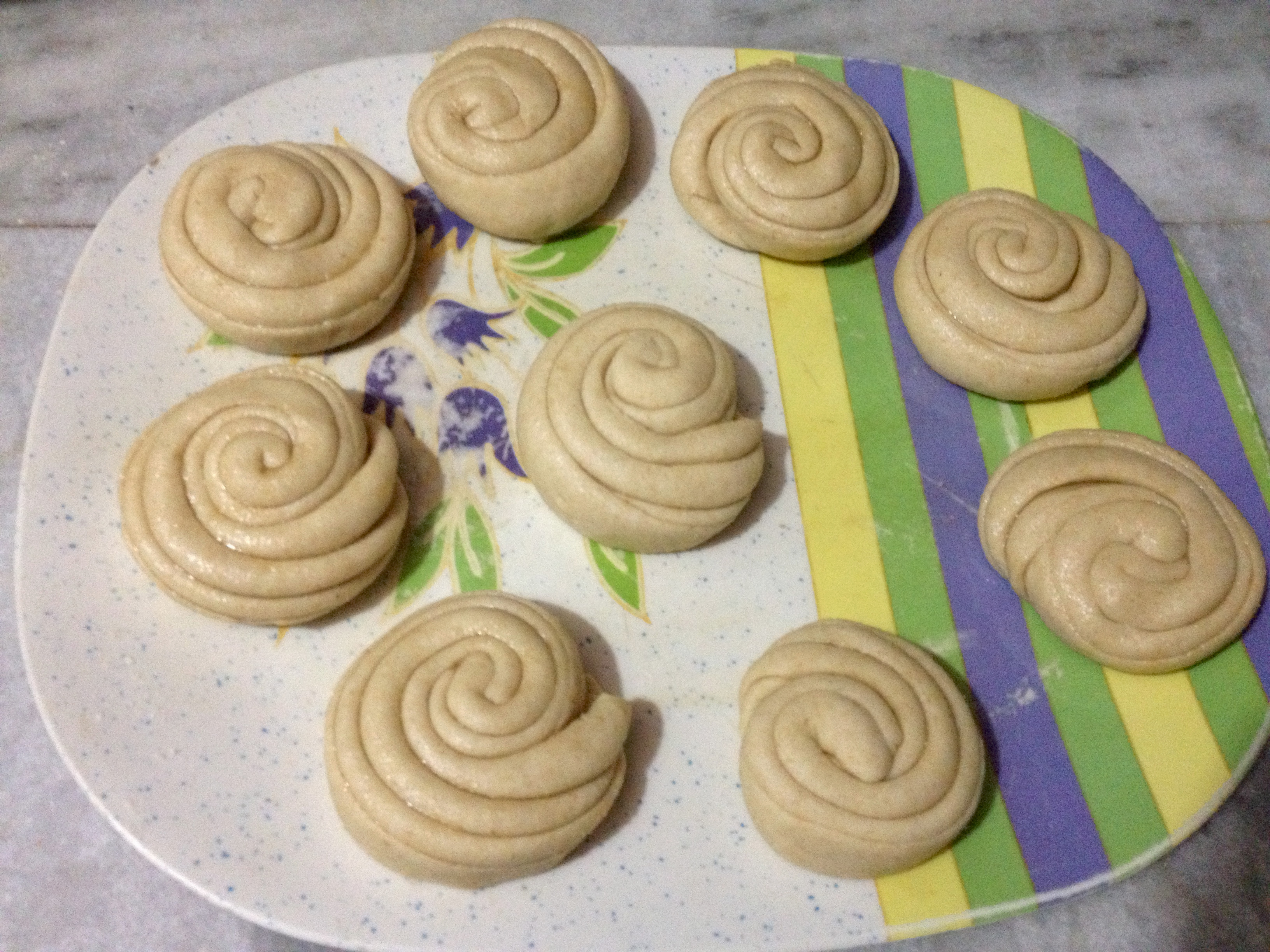 |
List Of Doughnut Varieties
Doughnuts are a type of fried dough food. The following is a list of doughnut varieties. Variations and specialties by region The terms below constitute either names for different doughnut types created using local recipes, or for the local language translation of the term for an imported doughnut product. * Argentina – Kreppel, also called ''tortas fritas'' (fried pastries), is a fried pastry or quick bread that was introduced by German immigrants, and is similar to the Berliner. Facturas are a popular baked doughnut found in every corner bakery. Other names that may be seen in bakeries are ''berlinesas'' and ''bolas de fraile'' ("friar's balls"). * Armenia – ''Ponchik'', borrowed from Russian, is a deep-fried piece of dough shaped into a flattened sphere and filled with confiture or other sweet filling. ''Tukalik'' are similar to doughnut holes, and Armenian doughnuts are referred to as ''chickies''. * Australia – Kitchener bun, Similar to Berliner, but with an open ... [...More Info...] [...Related Items...] OR: [Wikipedia] [Google] [Baidu] |
 |
Dough
Dough is a thick, malleable, sometimes elastic paste made from grains or from leguminous or chestnut crops. Dough is typically made by mixing flour with a small amount of water or other liquid and sometimes includes yeast or other leavening agents, as well as ingredients such as fats or flavorings. Making and shaping dough begins the preparation of a wide variety of foodstuffs, particularly breads and bread-based items, but also including biscuits, cakes, cookies, dumplings, flatbreads, noodles, pasta, pastry, pizza, piecrusts, and similar items. Dough can be made from a wide variety of flour, commonly wheat and rye but also maize, rice, legumes, almonds, and other cereals or crops. Types of dough Doughs vary widely depending on ingredients, the desired end product, the leavening agent (particularly whether the dough is based on yeast or not), how the dough is mixed (whether quickly mixed or kneaded and left to rise), and cooking or baking technique. There is no fo ... [...More Info...] [...Related Items...] OR: [Wikipedia] [Google] [Baidu] |
 |
Croustillons
An (, plural , fy, Oaljebol or Oaljekoek) is a traditional Belgian and Dutch beignet. They are called (literally: ''oil balls'') or (literally: ''lard balls'') in the Netherlands, (literally: ''lard balls'') in Flanders and (loosely: ''crispies'') in Wallonia, (same meaning as in Belgian Dutch ) in Eastern Belgium German. In France, with they are also commonly called (literally: ''fast beignets'') and croustillons hollandais (loosely: ''Dutch crispies''). In out-of-Belgium German, they are called (same meaning as in Dutch ), (informal for ''puppets'' or ''babies'') and (same meaning, especially used in Alsace for these ones), (loosely: ''messed up Saint Sylvesters'') in Northern Germany, and (loosely: ''fried mice'' or ''baked mice'') in Austrian German. In English they are more commonly known as Dutch doughnuts or dutchies. In Italy, they are called in many different ways and it depends on the Region: bombolini fritti, ficattole, bignoli, frittoli (or fritole/f ... [...More Info...] [...Related Items...] OR: [Wikipedia] [Google] [Baidu] |
 |
Oliebollen
An (, plural , fy, Oaljebol or Oaljekoek) is a traditional Belgian and Dutch beignet. They are called (literally: ''oil balls'') or (literally: ''lard balls'') in the Netherlands, (literally: ''lard balls'') in Flanders and (loosely: ''crispies'') in Wallonia, (same meaning as in Belgian Dutch ) in Eastern Belgium German. In France, with they are also commonly called (literally: ''fast beignets'') and croustillons hollandais (loosely: ''Dutch crispies''). In out-of-Belgium German, they are called (same meaning as in Dutch ), (informal for ''puppets'' or ''babies'') and (same meaning, especially used in Alsace for these ones), (loosely: ''messed up Saint Sylvesters'') in Northern Germany, and (loosely: ''fried mice'' or ''baked mice'') in Austrian German. In English they are more commonly known as Dutch doughnuts or dutchies. In Italy, they are called in many different ways and it depends on the Region: bombolini fritti, ficattole, bignoli, frittoli (or fritole/fri ... [...More Info...] [...Related Items...] OR: [Wikipedia] [Google] [Baidu] |
|
Malassada
A malasada ( pt, malassada, from "'' mal- assada''" = "badly-baked"; similar to filhós), sometimes called "Portuguese fried dough," is a Portuguese confection. It is a fried type of doughnut, made of flattened rounds of yeast dough, flavoured with lemon zest and coated with granulated sugar and cinnamon. The traditional Portuguese malasadas do not contain holes or any type of filling, but some variations do, especially the ones made in Hawaii. Some cream fillings include coconut, passion fruit, guava, pineapple and custard. Malasadas are often eaten on Mardi Gras - the day before Ash Wednesday. In Madeira, malasadas are mainly eaten on ''Terça-feira Gorda'' ("Fat Tuesday" in English; ''Mardi Gras'' in French) which is also the day before Lent begins. It is a traditional confection eaten in the Azores islands and in Madeira during the Portuguese Carnival (Carnival of Madeira in the Madeira Islands). Malasadas were created with the intention of using all the lard and sugar in on ... [...More Info...] [...Related Items...] OR: [Wikipedia] [Google] [Baidu] |
|
|
Filhó
A ''filhó'' (or ''filhós'' in plural) is a traditional dessert in Portugal and Northeastern Brazil. ''Filhós'' are usually made by forming balls from a mixture of flour and eggs. When the dough has risen, the balls are deep fried and sprinkled with a mixture of sugar and cinnamon. This is a traditional Christmas bake in Portugal. The Brazilian variety is not sprinkled and is usually covered with honey or with melted rapadura (which in Brazilian Portuguese is usually called "mel de rapadura"). See also *List of doughnut varieties * Ganmodoki, named after filhós in parts of Japan * Malasada, of Madeira ) , anthem = ( en, "Anthem of the Autonomous Region of Madeira") , song_type = Regional anthem , image_map=EU-Portugal_with_Madeira_circled.svg , map_alt=Location of Madeira , map_caption=Location of Madeira , subdivision_type=Sovereign st ...n origin * References External links * Portuguese desserts Christmas food Doughnuts Squash and pumpkin dishes ... [...More Info...] [...Related Items...] OR: [Wikipedia] [Google] [Baidu] |
|
|
Azores
) , motto= ( en, "Rather die free than subjected in peace") , anthem=( en, "Anthem of the Azores") , image_map=Locator_map_of_Azores_in_EU.svg , map_alt=Location of the Azores within the European Union , map_caption=Location of the Azores within the European Union , coordinates = , subdivision_type = Country , subdivision_name = , established_title=Settlement , established_date=1432 , established_title3=Autonomous status , established_date3=30 April 1976 , official_languages= Portuguese , demonym= ( en, Azorean) , capital_type=Capitals , capital = Ponta Delgada (executive) Angra do Heroísmo (judicial)Horta (legislative) , largest_city = Ponta Delgada , government_type= Autonomous Region , leader_title1=Representative of the Republic , leader_name1=Pedro Manuel dos Reis Alves Catarino , leader_title2= President of the Legislative Assembly , leader_name2= Luís Garcia , leader_title3= President of the Regional Government , le ... [...More Info...] [...Related Items...] OR: [Wikipedia] [Google] [Baidu] |
|
 |
Powdered Sugar
Powdered sugar, also called confectioners' sugar, or icing sugar, is a finely ground sugar produced by milling granulated sugar into a powdered state. It usually contains between 2% and 5% of an anti-caking agent – such as corn starch, potato starch or tricalcium phosphate – to absorb moisture, prevent clumping, and improve flow. Although most often produced in a factory, a proxy for powdered sugar can be made by processing ordinary granulated sugar in a coffee grinder, or by crushing it by hand in a mortar and pestle. Use Powdered sugar is used in industrial food production when a quick-dissolving sugar is required. Home cooks use it principally to make icing or frosting and other cake decorations. It is often dusted onto baked goods to add a subtle sweetness and delicate decoration. Powdered sugar is available in varying degrees of fineness, most commonly XXX, XXXX, and 10X: the greater the number of Xs, the finer the particles. Finer particles absorb more m ... [...More Info...] [...Related Items...] OR: [Wikipedia] [Google] [Baidu] |
%2C_January_2010.jpg) |
Icing (food)
Icing, or frosting, is a sweet, often creamy glaze made of sugar with a liquid, such as water or milk, that is often enriched with ingredients like butter, egg whites, cream cheese, or flavorings. It is used to coat or decorate baked goods, such as cakes. When it is used between layers of cake it is known as a filling. Icing can be formed into shapes such as flowers and leaves using a pastry bag. Such decorations are commonplace on birthday and wedding cakes. Edible dyes can be added to icing mixtures to achieve a desired hue. Sprinkles, edible inks or other decorations are often used on top of icing. A basic icing is called a glacé, containing powdered sugar (also known as icing sugar or confectioners' sugar) and water. This can be flavored and colored as desired, for example, by using lemon juice in place of the water. More complex icings can be made by beating fat into powdered sugar (as in buttercream), by melting fat and sugar together, by using egg whites (as in r ... [...More Info...] [...Related Items...] OR: [Wikipedia] [Google] [Baidu] |
 |
Cafe Mocha
A coffeehouse, coffee shop, or café is an establishment that primarily serves coffee of various types, notably espresso, latte, and cappuccino. Some coffeehouses may serve cold drinks, such as iced coffee and iced tea, as well as other non-caffeinated beverages. In continental Europe, cafés serve alcoholic drinks. A coffeehouse may also serve food, such as light snacks, sandwiches, muffins, fruit, or pastries. Coffeehouses range from owner-operated small businesses to large multinational corporations. Some coffeehouse chains operate on a franchise business model, with numerous branches across various countries around the world. While ''café'' may refer to a coffeehouse, the term "café" generally refers to a diner, British café (colloquially called a "caff"), "greasy spoon" (a small and inexpensive restaurant), transport café, teahouse or tea room, or other casual eating and drinking place. A coffeehouse may share some of the same characteristics of a bar or restaurant, b ... [...More Info...] [...Related Items...] OR: [Wikipedia] [Google] [Baidu] |
 |
Custard
Custard is a variety of culinary preparations based on sweetened milk, cheese, or cream cooked with egg or egg yolk to thicken it, and sometimes also flour, corn starch, or gelatin. Depending on the recipe, custard may vary in consistency from a thin pouring sauce ('' crème anglaise'') to the thick pastry cream (''crème pâtissière'') used to fill éclairs. The most common custards are used in custard desserts or dessert sauces and typically include sugar and vanilla; however, savory custards are also found, e.g., in quiche. Custard is usually cooked in a double boiler ( bain-marie), or heated very gently in a saucepan on a stove, though custard can also be steamed, baked in the oven with or without a water bath, or even cooked in a pressure cooker. Custard preparation is a delicate operation, because a temperature increase of 3–6 °C (5–10 °F) leads to overcooking and curdling. Generally, a fully cooked custard should not exceed 80 °C (~17 ... [...More Info...] [...Related Items...] OR: [Wikipedia] [Google] [Baidu] |